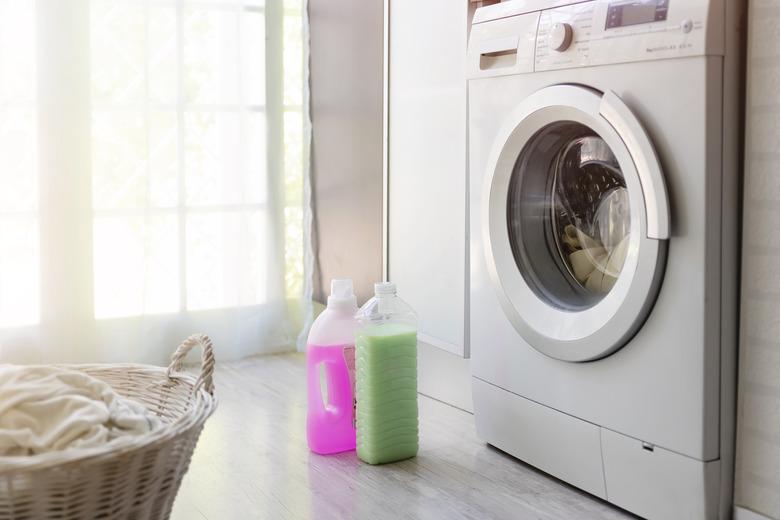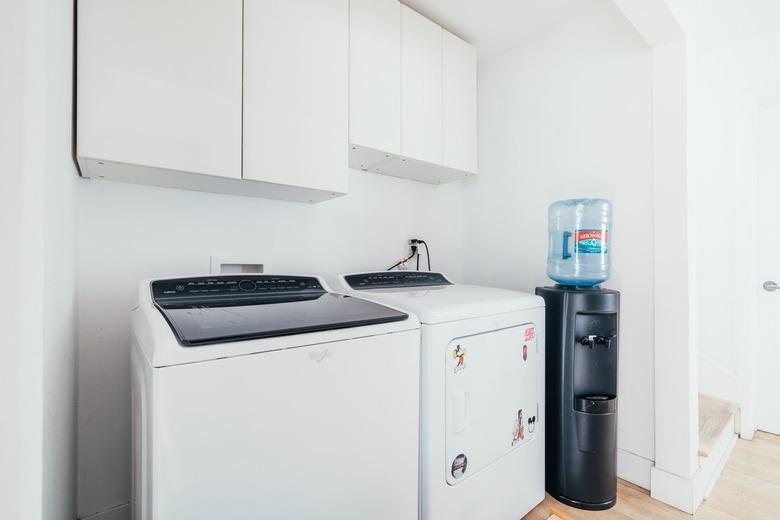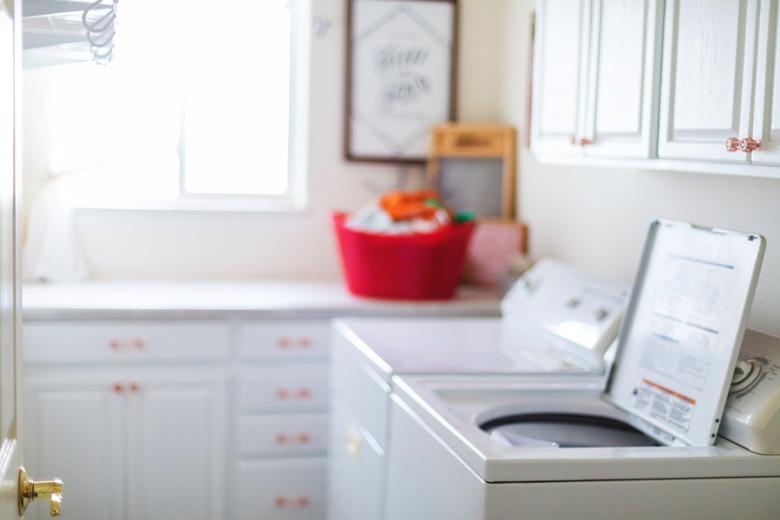Your Washing Machine Is Likely Filled With Mold. Here's How To Clean It
No matter if you use a front-loader or a top-loader, there's a good chance mold and funky gunk are hiding in there. If your clothes don't smell as clean as they once did, the machine itself might be the culprit. Today's machines are better at many things, but they're also more inclined to suffer from a mold buildup because they're more efficient and work better at lower temperatures.
But washing machines don't need to be plagued by mold no matter how efficient they are if you stay on top of maintenance. Experts say one thing is clear: Moisture problems affect most styles of washing machines, but regular maintenance and proper use go a long way toward keeping your machine mold-free and your laundry smelling fresh.
How to Clean Mold Out of a Front-Loading Washing Machine
If your front-load washer is giving you grief with mold, you're not alone. You could almost say the mold problem with these machines is by design because those front doors need to be watertight, which means airtight, and that's the problem.
Here's how to do a proper mold removal on a front-loading washer:
Tip
When a load finishes, wipe the inside dry and then leave the door open so water residue can evaporate. With some machines, that's not enough, as evidenced by consumers successfully winning class-action lawsuits over the issue in recent years. If your machine persists with mold issues, online sleuthing may reveal that other people report similar problems with that model, offering possible solutions or other actions to take.
1. Clean the Door Gasket
The rubber seal on the door is where a lot of mold spores hide. Because mold is hazardous, wear rubber gloves and protective goggles when cleaning the door's gasket. If you have asthma or a mold allergy, wear a respirator mask.
Dilute 3/4 cup of bleach in 1 gallon of water. It's far more solution than you'll need, but store it in a gallon jug and you'll be set for cleaning the gasket monthly, which is the minimum that manufacturers recommend. Use a soaked cloth or sponge to wipe around the door seal. Be sure to get in the crevices and all sides of the seal and clean it thoroughly. Wipe it dry with a clean cloth but leave the door open for it to air-dry completely when you're finished.
Warning
Never use vinegar to clean the gasket, as white vinegar damages rubber. Bleach works but always dilute bleach with water or it will damage the rubber gasket and metal washer parts.
Most models will allow for removing the soap dispenser but turn off the machine and unplug it for safety.
- Extend the drawer completely. There should be a
latch to press so you can remove the drawer from the machine. Press the latch
and remove it. Cleaning it is best done at a sink. Remove the inserts from the
drawer. Don't add soap, just warm water, and then scrub with a soft brush or cloth
and then rinse with warm water until no soap or mold remains. Wipe it dry and then
allow it to air-dry completely. - While still unplugged, clean the drawer
opening before returning the drawer. Use a small, nonmetal brush, like an old
toothbrush, to brush off any crusty soap residue. Use a dry cloth to wipe
loosened residue but wipe outwardly to prevent residue from falling inside the
machine. - Replace the drawer.
Most front-load machines come with a "tub clean" cycle that may have another name, but the premise is the same. Running this cycle monthly or more often if you're a "power user" should help the machine stay in top shape. Always run the machine empty for this cycle. If you're currently suffering persistent smells or residue, run this cycle once weekly for three weeks. For machines without a cleaning cycle, use the hottest, longest cycle available. Clean the laundry detergent dispenser before running the tub-cleaning cycle for best results.
With the washing drum empty, add your cleaning agent. Use only one kind of cleaner at a time and only the recommended quantity. If using a drum cleaner, you can do the lime scale remover at the same time. Where you put the cleaning product depends on what you're using. For drum cleaner, powdered cleaner, and lime scale remover, put them in the detergent dispenser. For cleaning tablets, put them directly inside the drum. For bleach, add it to the bleach compartment. Bleach is great for disinfecting the machine in general, especially when people in your home have been ill.
Close the door and then start the machine and the tub clean cycle as the user manual suggests. Once the cycle has run through, open the door to allow it to dry completely.
How to Clean Mold Out of a Top-Loading Washing Machine
While mold in a washing machine is known to be a common problem with front-loading washing machines, it's a problem that affects top-loaders too. But the machines do have different parts and slightly different cleaning processes, so proceed accordingly.
Here's how to get rid of mold on a top-loading washer:
1. Clean the Soap Dispenser
For many top-loading machines, removing the soap dispenser is not an option. If there's a dispenser drawer and removing it is possible, do so. Your manual should specify if your model's dispenser can be removed.
Use a wet cloth to wipe the dispenser clean until there's no residue remaining. Dry it thoroughly.
Most modern machines have modes with names like "mold clean" or "tub clean," and these are all essentially a washing cycle that uses a higher water volume to get your tub clean. On older machines, the hottest, longest cycle you have will accomplish the same. When running cleaning cycles in top-loading machines, don't add detergent to the machine. Manufacturers recommend using washer-cleaner tablets, like True Fresh, or bleach. Use one or the other, not both.
- For tablets, simply add one to the drum, not the detergent dispenser, and then close the lid and start the tub-cleaning cycle as your model requires. For bleach, add 1 cup of bleach to the bleach dispenser with no detergent or other chemicals, close the lid, and run the cleaning cycle.
- Once the cycle starts, don't stop the process; let it run through.
- When finished, raise the lid and allow it to air-dry overnight at a minimum, but manufacturers suggest leaving the door open at all times when the machine is not in use.
How to Clean Mold Out of an Old Model Top-Loading Washing Machine
The older your machine, the more you may have to do to get it sparkling clean. It's worth doing because it won't just make clothes smell better; it may extend the life of your machine. Areas you'll have to clean will include the agitator, beneath the agitator, the tub cover, and the inner basket.
Because it's a more in-depth job, this video from PartSelect is a terrific place to learn what to do for periodic deep cleaning every few years depending on your machine's needs and how humid your laundry room tends to be, especially if it's in the basement.
How to Prevent Mold and Mildew in a Washing Machine
While there are other areas you could clean, like water inlet filters and the drain pump filters, they're not particularly relevant to regular mold maintenance in most machines. Even if things are off-kilter right now, a cluster of weekly "tub clean" cycles with bleach might get you back on track without further efforts, but your manual will give you the lowdown if you feel you need to tackle those as well.
The worst culprit for mold and mildew is always trapped moisture, so following these steps will help avoid grime and mold over the long term. When you buy a new machine, following these tips from day one will make all the difference.
- Always leave the washer door open when you're finished so moisture
dissipates from the drum, but giving it a wipe-down with a clean, dry cloth can
make that more efficient. Do this when every wash day is over, and you'll
have fewer problems over time. Make sure everyone in your household knows that
the washer door being left open is a good thing and not to close it. - Always use the right detergent. High-efficiency machines
need high-efficiency detergent and only the recommended amount, or you could compound your machine's likelihood for mold. - While machines today excel in cold-water cycles, cold water
is problematic for mold growth. Use warm- and hot-water cycles
periodically to ensure your machine runs at its best. - While manufacturers advise you to do the tub-cleaning
cycle once a month, that monthly cleaning recommendation really means 30 loads
or a month, whichever comes first. If you're a laundry power-user (like busy parents
often are), then you may hit 30 wash loads sooner than most people, and your
maintenance should be more frequent.
It can be exasperating when you need to clean the machine that's meant to be doing the cleaning, but it's key to keeping it performing at its best. If it extends your machine's life cycle by a few years, it'll have proven to be more than worth your time.



